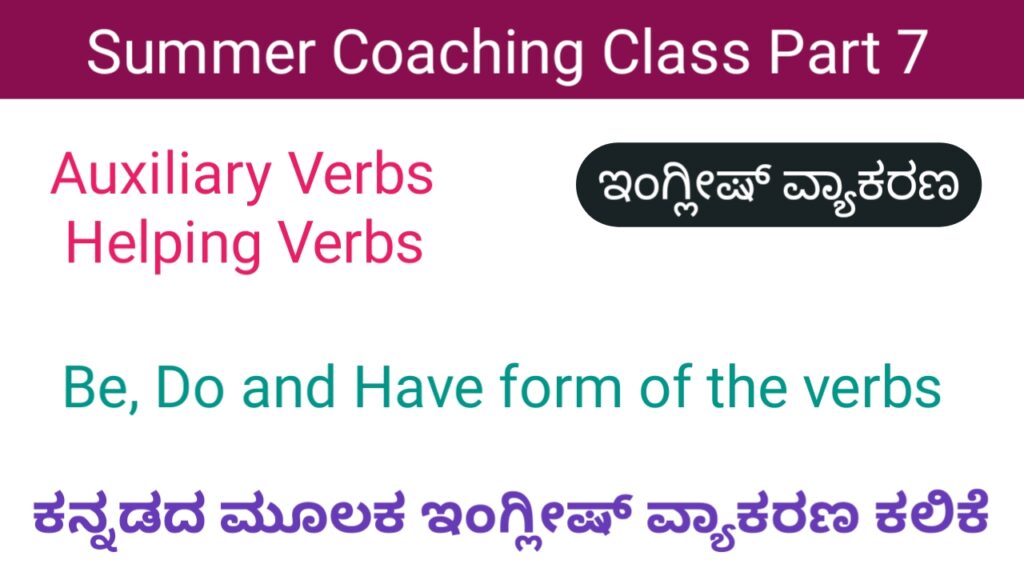Auxiliary verbs in English grammar. These are also called as helping verbs. Learn helping verbs in English grammar.
In English there are two types of auxiliary verb, primary auxiliaries and modal auxiliaries. The three primary auxiliary verbs are ‘be’, ‘have’ and ‘do’. There are ten common modal auxiliary verbs and they are ‘can’, ‘could’, ‘will’, ‘would’, ‘shall’, ‘should’, ‘may’, ‘might’, ‘must’ and ‘ought’.

To get more grammar videos, visit our YouTube channel. This channel is very useful for all competition exam preparation.
Click to download Auxiliary verbs
Watch this video for the explanation of Auxiliary verbs in English grammar.
helping verbs exercises with answers
What are the auxiliary verbs?
“People use auxiliary verbs (also called helping verbs) along with a main verb to express tense, mood, or voice.”
For example, in the statement “He is writing,” “is” functions as an auxiliary verb indicating that the action of the main verb (“writing”) is ongoing.
2 Types of Auxiliary Verbs
Auxiliary verbs can be broken down into two main categories:
1. Primary auxiliary verbs and
2. Modal auxiliary verbs.
1. Primary auxiliary verbs: “The primary auxiliary verbs—’be,’ ‘do,’ and ‘have’—can conjugate to form different tenses, voices, and moods.”These verbs can also function as action verbs.
2. Modal auxiliary verbs: Modal auxiliary verbs include “can,” “could,” “would,” “should,” “shall,” “might,” “may,” “must,” “will,” “need,” “dare,” and the phrases “ought to” and “used to.” You cannot conjugate modal auxiliary verbs. Verbs in base form, or the bare infinitive, follow modal auxiliary verbs.
What are the 3 types of auxiliary verb?
The three primary auxiliary verbs are
| BE | DO | HAVE |
| am is are was were being been will be | do does did will do | have has had having will have |
“An auxiliary verb is a verb that works together with a main verb to show time and continuity.”
‘Be’ and ‘have’ are the primary auxiliaries. A primary auxiliary is used to construct compound tenses.
‘Be’ is used to make present continuous and past continuous tenses.
Examples:
I am walking.
Sharada is using the computer.
They were all wondering about the match.
Kiran was learning in USA in 1995.
They have been learning about coding.
and also for the passive:
These pens are sold in college.
Martin was arrested and held overnight.
auxiliary verbs examples
‘Have’ is used to make present perfect and past perfect tenses.
Meera has finished fixing the bike.
Girish and Anjali have seen the show already.
My father had already slept when we arrived.
They had not expected to see us there.
‘Do’ is the supporting auxiliary. It is used in forming negatives, questions, and emphatic statements.
I do not like this show.
Do you like coffee?
You do like prawns, don’t you?
He does not play football.
He did not play football.
Do they come from Vietnam?
Does she drive to work?
More examples for practice:
1. He ________ studying for his exam.
2. They _______ playing soccer in the park.
3. He _______ not been feeling well lately.
4. We _______ decided to go on vacation this summer.
5. He ________ not like spicy food.
6. We ________a lot of sightseeing on our trip to Europe.
7. ___________ she not pass the test?
8. you _______ reading a book right now.
Answer:
1. is
2. are
3. has
4. have
5. does
6. did
7. Did
8. are
